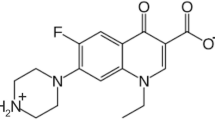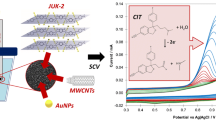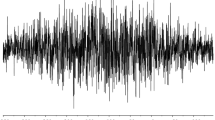Abstract
The preparation of a hybrid containing arginine and Na montmorillonite (Na-Mt) was optimized by studying the effect of several parameters. The obtained samples were characterized by X-ray diffraction (XRD), infrared spectroscopy (IR), and differential scanning calorimetry (DSC). These techniques approved the modification by the increase of the basal distance and the shift of the characteristic peaks of thermal analysis. The hybrid obtained in the optimal conditions was selected, incorporated in a graphite-based electrode, and tested in the analysis of the active molecule metronidazole (MTZ) by cyclic voltammetry (CV). The best electrochemical response was obtained in the conditions (pH = 9, CEC = 2, and stirring time = 12 h) and an optimum amount of hybrid was required in the electrode composition to have a well-defined cathodic peak corresponding to the reduction of MTZ. Results showed that the elaborated electrode reaction exhibits a diffusion-controlled process which is in agreement with several studies using other types of electrodes.
Graphical abstract



















Similar content being viewed by others
References
M’bodj O, Ariguib NK, Ayadi MT, Magnin A (2004) Plastic and elastic properties of the systems interstratified clay-water-electrolyte-xanthan. J Colloid Interface Sci 273:675–684. https://doi.org/10.1016/j.jcis.2004.02.028
Gamoudi S, Srasra E (2017) Characterization of Tunisian Clay suitable for pharmaceutical and cosmetic applications. Appl Clay Sci 146:162–166. https://doi.org/10.1016/j.clay.2017.05.036
Zhang YQ, Lee JH, Rhee JM, Rhee KY (2004) Polypropylene-clay nanocomposites prepared by in situ grafting-intercalating in melt. Comp Sci Technol 64:1373–1389. https://doi.org/10.1016/j.compscitech.2003.10.014
Sinegani AAS, Emtizai G, Shariamadari H (2005) Sorption and immobilization of cellulase on silicate clay minerals. J Colloid Interface Sci 290:39–44. https://doi.org/10.1016/j.jcis.2005.04.030
Yilmaz N, Yapar S (2004) Adsorption properties of tetradecyl- and hexadecyl trimethylammonium bentonites. Appl Clay Sci 27:223–228. https://doi.org/10.1016/j.clay.2004.08.001
Mellah B, Sall D, Msaddak I, Srasra E (2019) Intercalation of 8-hydroxyquinoline into Na(I)- and Zn(II)-Tunisian montmorillonites: characterization and luminescence properties of elaborated hybrids. J Incl Phenom Macrocycl Chem 94:309–318. https://doi.org/10.1007/s10847-018-0826-9
Dias PM, De Faria DLA, Constantino VRL (2000) Spectroscopic studies on the interaction of Tetramethyl pyridyl porphyrins and Cationic Clays. J Incl Phenom Macrocycl Chem 38:251–266. https://doi.org/10.1023/A:1008173315471
Moro D, Ulian G, Valdrè G (2015) Single molecule investigation of glycine–chlorite interaction by cross-correlated scanning probe microscopy and quantum mechanics simulations. Langmuir 31:4453–4463. https://doi.org/10.1021/acs.langmuir.5b00161
Moro D, Ulian G, Valdrè G (2019) Amino acids-clay interaction at the nano-atomic scale: the L-alanine-chlorite system. Appl Clay Sci 172:28–39. https://doi.org/10.1016/j.clay.2019.02.013
Gopinath S, Sugunan S (2007) Enzymes immobilized on montmorillonite K10: effect of adsorption and grafting on the surface properties and the enzyme activity. Appl Clay Sci 35:67–75. https://doi.org/10.1016/j.clay.2006.04.007
McLaren AD, Peterson GH, Bakshad I (1958) The adsorption and reactions of enzymes and proteins on clay minerals: IV. kaolinite and Montmorillonite. Soil Sci Soc Am Proc 22:239–244. https://doi.org/10.2136/sssaj1958.03615995002200030014x
Öztürk N, Tabak A, Akgöl S, Denizli A (2007) Newly synthesized bentonite–histidine (Bent–Hist) micro-composite affinity sorbents for IgG adsorption. Colloids Surf A Physicochem Eng Asp 301:490–497. https://doi.org/10.1016/j.colsurfa.2007.01.026
Pires J, Juźków J, Pinto ML (2018) Amino acid-modified montmorillonite clays as sustainable materials for carbon dioxide adsorption and separation. Colloids Surf A Physicochem Eng Asp 544:105–110. https://doi.org/10.1016/j.colsurfa.2018.02.019
Wang XC, Lee C (1993) Adsorption and desorption of aliphatic amines, amino acids and acetate by clay minerals and marine sediments. Mar Chem 44:1–23. https://doi.org/10.1016/0304-4203(93)90002-6
Fraser Donald G, Christopher Greenwell H, Skipper Neal T, Smalley Martin V, Wilkinson Michael A, Demé. Bruno, Heenan RK (2011) Chiral interactions of histidine in a hydrated vermiculite clay. Phys Chem Chem Phys 13:825–830. https://doi.org/10.1039/C0CP01387K
Kollar T, Palinko I, Konya Z, Kiricsi I (2003) Intercalating amino acid guests into montmorillonite host. J Mol Struct 335:651–653. https://doi.org/10.1016/S0022-2860(03)00109-1
Yuting C, Muhammad AK, Fengyun W, Mingzhu X, Wu L, Sidi Z (2019) Kinetics and equilibrium isotherms of adsorption of Pb(II) and Cu(II) onto raw and arginine-modified montmorillonite. Adv Powder Technol 30:1067–1078. https://doi.org/10.1016/j.apt.2019.03.002
Shokria E, Yegania R, Akbarzadeh (2017) A novel adsorptive mixed matrix membranes by embedding modified montmorillonite with arginine amino acid into polysulfones for As(V) removal. Appl Clay Sci 144:141–149. https://doi.org/10.1016/j.clay.2017.05.011
Wahab N, Saeed M, Ibrahim M, Munir A, Saleem M, Zahra M, Waseem A (2017) Synthesis, characterization, and applications of silk/Bentonite Clay composite for heavy metal removal from aqueous solution. Front Chem 7:654. https://doi.org/10.3389/fchem.2019.00654
Fu L, Weckhuysen MB, Verberckmoes AA, Schoonheydt AR (1996) Clay intercalatedCu(II) amino acid complexes” synthesis, spectroscopy and catalysis. Clay Min 31:491–500. https://doi.org/10.1180/claymin.1996.031.4.06
Quan F, Dan S, Huaiguo X, Yuanyuan H, Serge C (2007) Amperometric phenol biosensor based on laponite clay–chitosan nanocomposite matrix. Biosens Bioelectron 22:816–821. https://doi.org/10.1016/j.bios.2006.03.002
Ghoneim EM, El-Desoky HS (2010) Electrochemical determination of methocarbamol on a montmorillonite-Ca modified carbon paste electrode in formulation and human blood. Bioelectrochemistry 79:241–247. https://doi.org/10.1016/j.bioelechem.2010.06.005
Orata D, Amir Y, Nineza C, Mukabi M (2014) Electrochemical characterization of amoxycillin, a broad spectrum antibiotic on a Bentonite host matrix, using cyclic voltammetry. IOSR-JAC 7:50–58. https://doi.org/10.9790/5736-07535058
La-Scalea MA, Serrano SHP, Gutz IGR (1999) Comportement voltampérométrique du métronidazole aux électrodes de mercure. J Chem Soc Brésilienne 10:127–135. https://doi.org/10.1590/S0103-50531999000200010
Leitsch D (2017) A review on metronidazole: an old warhorse in antimicrobial chemotherapy. Parasitology. https://doi.org/10.1017/S0031182017002025
Jianzhi H, Xiaolei S, Ruili W, Qiang Z, Lishi W (2017) A highly sensitive metronidazole sensor based on a Pt nanospheres/polyfurfural film modified electrode. RSC Adv 7:535–542. https://doi.org/10.1039/c6ra25106d. )
Yosef N, Meareg A (2016) Electrochemical determination of metronidazole in tablet samples using carbon paste electrode. J Anal Methods Chemdoi. https://doi.org/10.1155/2016/3612943.
Shaofang L, Kangbing W, Xueping D, Shengshui H (2004) Electrochemical reduction and voltammetric determination of metronidazole at a nanomaterial thin film coated glassy carbon electrode. Talanta 63:653–657. https://doi.org/10.1016/j.talanta.2003.12.005
Benna M, Kbir-Ariguib N, Clinard C, Bergaya F (2001) Static filtration of a purified sodium bentonites clay suspensions. effect of clay percentage. Appl Clay Sci 117:204–210. https://doi.org/10.1016/S0169-1317(01)00050-3
Taylor RK (1985) Cation exchange in clays and mud rocks by methylene blue. J Chem Technol Biotechnol 35:195–207. https://doi.org/10.1002/jctb.5040350407
Yamada H, Yoshioka K, Tamura K, Fujii K, Nakazawa H (1999) compositional gap in dioctahedral-trioctahedral smectite system: beidellite-saponite pseudo-binary join. Clays Clay Miner 47:803–810. https://doi.org/10.1346/ccmn.1999.0470616
Brindley GW, Brown G (1980) Cristal structures of clay minerals and their X-ray identification. In Mineralogical Society Monograph, London
Caillère S, Hènin S, Rautureau M (1982) Minéralogie des argiles, (Tome 1&2), Masson
Oliveira Brett AM, Serrano SHP, La-Scalea MA, Gutz IGR, Cruz ML (1999) Mechanism of interaction of in situ produced nitroimidazole reduction derivatives with DNA using electrochemical DNA biosensor. Oxidants and Antioxidants Part B 300:314–332. https://doi.org/10.1016/S0076-6879(99)00137-8
Yiliyasi B, Xamxikamar M, Mailidan W, Muhebaiti M, Haji AA, Guangzhi H (2020) Electrochemical determination of metronidazole using a glassy carbon electrode modified with nanoporous Bimetallic carbon derived from a ZnCo-based metal-organic framework. J Electrochem Soc 167:116513. https://doi.org/10.1149/1945-7111/ab9d94
Brett AM, O SHP, Serrano GI, La-Scalea MA (1997) Electrochemical reduction of metronidazole at a DNA-modified glassy carbon electrode. Bioelectrochem Bioenerg 42:175–178. https://doi.org/10.1016/s0302-4598(96)05122-7
Mei Y, Manli G, Yanlong F, Yanming L, Yujuan C, Debin Z, Ying Y, Li D (2018) Sensitive voltammetric detection of metronidazole based on three-dimensional Graphene-like carbon architecture/polythionine modified glassy carbon electrode. J Electrochem Soc 165(11):530–535. https://doi.org/10.1149/2.1311811jes
Baharak S, Reza S, Emamali, Farshad K, Abbas N (2015) Sensitive determination of metronidazole based on Graphene-TiO2 modified glassy carbon electrode in human serum and urine samples. Eur J Chem 6:31–36. https://doi.org/10.5155/eurjchem.6.1.31-36.1138
Satar T, Yrysgul B, Jianzhi H, Lishi W (2018) Ultrasensitive electrochemical determination of metronidazole based on polydopamine/carboxylic multi-walled carbon nanotubes nanocomposites modified GCE. J Pharm Anal 8:124–130. https://doi.org/10.1016/j.jpha.2017.11.001
Acknowledgements
The authors would like to thank Professor Fathi Safta and the Tunisian Pharmaceutical Industries Company for providing us with metronidazole.
Author information
Authors and Affiliations
Corresponding author
Ethics declarations
Conflict of interest
The authors declare that they have no known competing financial interests or personal relationships that could have appeared to influence the work reported in this paper.
Additional information
Publisher’s Note
Springer Nature remains neutral with regard to jurisdictional claims in published maps and institutional affiliations.
Supplementary Information
Below is the link to the electronic supplementary material.
Rights and permissions
Springer Nature or its licensor (e.g. a society or other partner) holds exclusive rights to this article under a publishing agreement with the author(s) or other rightsholder(s); author self-archiving of the accepted manuscript version of this article is solely governed by the terms of such publishing agreement and applicable law.
About this article
Cite this article
Touati, M., Maatoug, M., Mellah, B. et al. Potential electrode based on montmorillonite and amino acid hybrid for the retention of MTZ. J Appl Electrochem 53, 331–343 (2023). https://doi.org/10.1007/s10800-022-01763-1
Received:
Accepted:
Published:
Issue Date:
DOI: https://doi.org/10.1007/s10800-022-01763-1




